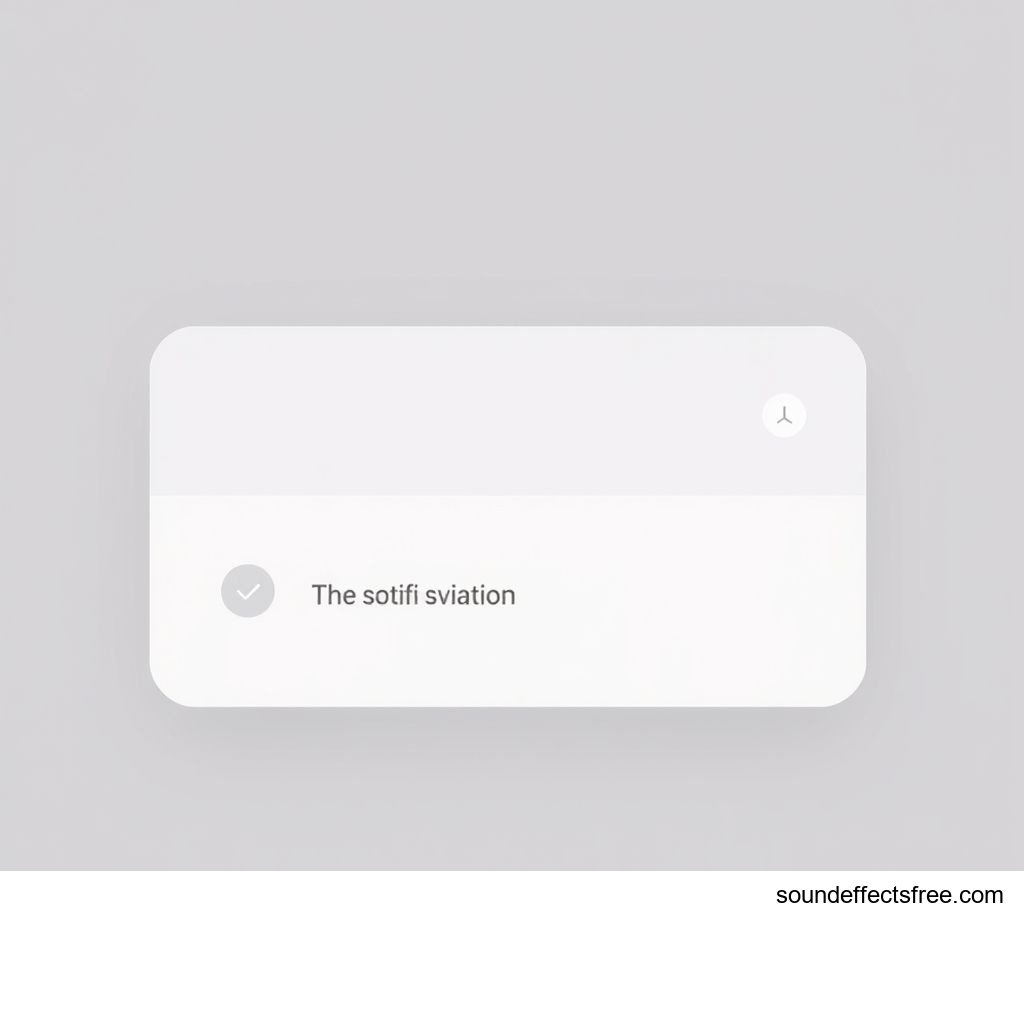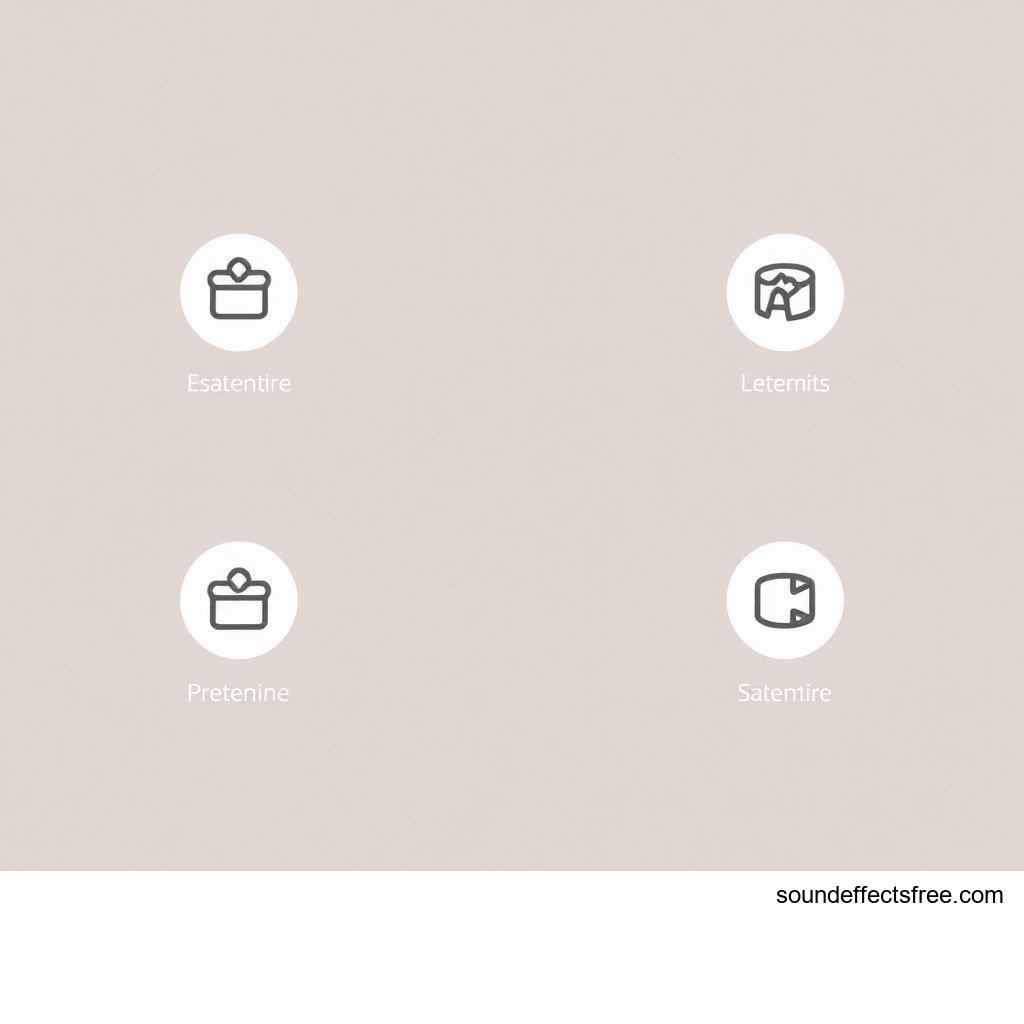Zenith Tap: Crafting Perfect UI Audio
Meta Description: Discover Zenith Tap, the art of subtle UI audio. Learn to craft minimalist sound samples and high-frequency effects for modern user interfaces.
The sound of a simple UI element click can define user experience. Every modern digital interface relies on UI sound. A perfect UI sound is subtle yet effective. It guides the user seamlessly. This article explores the "Zenith Tap." It's an ideal example of minimalist UI audio. We will delve into its creation and application. Understanding subtle UI sounds is crucial.
Applications in Media
The "Zenith Tap" is more than just a sound. It's a design choice for user interfaces. This clean audio effect enhances digital interactions. It provides instant feedback. Think about mobile apps or web pages. Each UI interaction can benefit from well-designed audio. This subtle tap sound makes every user selection clear.
Industry-Specific Uses
Many industries use UI sounds. Gaming is a prime example. Every menu UI action needs a quick blip. Medical devices also benefit. Clear audio feedback is vital there. Financial platforms use UI sounds for transaction confirmations. Educational apps utilize these sounds too. They make learning more engaging. The right UI sound enhances usability across sectors. It ensures a consistent user experience.
Creative Techniques
Crafting the perfect UI sound involves art. It needs scientific precision. Designers often layer small audio effects. They shape these sounds to fit the UI. A gentle tap can signal success. A distinct blip might alert the user. These sounds are often short and crisp. They avoid being intrusive. Creative use of silence is also key. The "Zenith Tap" exemplifies this balance. It's a clean, decisive audio effect.
Technical Analysis
Understanding the technical aspects is vital. It helps in creating effective UI audio. The "Zenith Tap" showcases specific characteristics. These characteristics make it highly usable. Its technical profile is clean and precise. Such sounds are engineered for clarity.
Waveform Characteristics
The "Zenith Tap" features a very short duration. Its waveform shows a rapid attack. Then, it has an equally swift decay. This transient nature is important. It ensures the sound doesn't linger. It prevents auditory clutter. The initial peak is sharp. This peak conveys immediate feedback. The rapid decline makes the sound efficient. This specific waveform works well for any UI. It's an ideal sound sample.
Frequency Profile
This UI sound focuses on high-frequency content. Most of its energy resides above 5 kHz. This high-frequency emphasis ensures clarity. It cuts through ambient noise. A high-frequency sound is often perceived as sharp. It feels precise. Yet, it avoids being piercing. The "Zenith Tap" has minimal low-end rumble. This prevents it from sounding muddy. Its bright, high-frequency character is perfect. It provides clear, concise UI feedback.
Production Tips
Creating your own "Zenith Tap" is achievable. You need the right approach. It involves careful recording and editing. The goal is a clean, sharp audio effect. Pay attention to every detail.
Recording & Editing
Start with high-quality source material. A small, dry tap works well. Use a sensitive microphone. Record in a quiet environment. This minimizes unwanted noise. Digital audio workstations (DAWs) are essential. Edit out any reverb or echo. Trim the sound precisely. Focus on the very beginning of the tap. Remove any unnecessary tail. Apply a subtle fade-out. This makes the UI sound clean.
Software Tools
Many software tools can help. Audio editors like Audacity are great for basic tasks. Professional DAWs offer more control. Think Logic Pro or Ableton Live. Use equalization (EQ) to shape the sound. Boost the high-frequency range. Cut out any muddy low-end. Compression can add punch. Limiting prevents distortion. Experiment with tiny amounts of reverb for subtle depth. But remember, the goal is a dry, clean UI sound. Many sound effect libraries also offer pre-made UI sounds. Consider checking out Pro Sound Effects for professional libraries.
Creative Implementation
Once you have a great UI sound, how do you use it? Creative implementation makes a difference. It can elevate the entire user experience. Consider how sounds interact with each other.
Layering Methods
Layering can add richness. Combine a "Zenith Tap" with another subtle blip. Perhaps a very short, quiet sub-bass element. This adds weight without muddiness. Be careful not to over-layer. Each layer should serve a purpose. The combined audio effect should remain clean. Too many layers can create a distracting sound. The key is subtlety for UI feedback. Explore Related UI sounds for inspiration.
Spatial Effects
Even simple UI sounds can benefit from spatialization. Imagine a menu selection. The sound could subtly pan to the selected item's location. This adds a sophisticated touch. Small amounts of stereo width can open up the sound. Avoid heavy reverb for spatial effects. Instead, use short delays or precise panning. These techniques enhance the UI experience. They make the interaction feel more real.
Sound Pack Integration
The "Zenith Tap" is often part of a larger sound pack. These packs offer cohesive audio solutions. Integrating them correctly is vital.
Using with Other Sounds
A complete UI sound collection works together. The "Zenith Tap" might be for a simple button press. A different blip might indicate an error. A longer, more melodic sound could signal completion. Ensure all your UI sounds share a similar aesthetic. They should feel like they belong together. This creates a harmonious UI. It makes the user experience consistent. Consider how each sound sample complements others. The goal is a unified audio effect.
Complete Collection
Building a robust UI is essential for modern applications. The "Zenith Tap" is one component. A full sound pack provides consistency. It ensures every blip and tap aligns. These packs offer comprehensive audio solutions. They save development time. They also guarantee high-quality UI audio. This consistency elevates any user interface. Get the full sound pack for comprehensive audio solutions. For a specific example, check out our UI Confirm Tap.
Conclusion
The "Zenith Tap" represents minimalist UI audio design. It embodies clarity and efficiency. Crafting such subtle sound effects is an art. It demands technical understanding. From its high-frequency profile to its crisp blip, every detail matters. Well-designed UI sound enhances user interaction. It guides and informs without intrusion. Investing in quality UI audio makes a significant difference. It creates intuitive and enjoyable digital experiences for everyone. A perfect tap can elevate your UI.
FAQ Section
Q1: What defines a good minimalist UI sound? A1: A good minimalist UI sound is short, clear, and non-intrusive. It provides immediate feedback. It usually has a sharp attack and quick decay. It avoids being distracting.
Q2: Why are high-frequency sounds preferred for UI feedback? A2: High-frequency sounds cut through background noise effectively. They are perceived as precise. This makes them ideal for clear UI feedback. They ensure the user hears every selection.
Q3: Can I create a "Zenith Tap" style sound with free software? A3: Yes, you can. Software like Audacity offers powerful editing tools. You can record a simple tap. Then, apply EQ and trimming techniques. This helps achieve that clean, high-frequency sound sample.
Q4: How many UI sounds does a typical app need? A4: The number varies, but common UI sounds include taps, blips, confirms, errors, and alerts. A complete set ensures consistent feedback for various user selection actions.
Q5: What is the primary benefit of consistent UI audio across an application? A5: Consistent UI audio greatly improves user experience. It creates a cohesive and intuitive interface. Users learn the audio cues quickly. This makes interactions feel natural and efficient.





